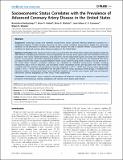| dc.contributor.author | Bashinskaya, Bronislava | |
| dc.contributor.author | Nahed, Brian Vala | |
| dc.contributor.author | Walcott, Brian Patrick | |
| dc.contributor.author | Coumans, Jean-Valery C E | |
| dc.contributor.author | Onuma, Oyere Kalu | |
| dc.date.accessioned | 2013-04-05T15:18:34Z | |
| dc.date.issued | 2012 | |
| dc.identifier.citation | Bashinskaya, Bronislava, Brian V. Nahed, Brian P. Walcott, Jean-Valery C. E. Coumans, and Oyere K. Onuma. 2012. Socioeconomic status correlates with the prevalence of advanced coronary artery disease in the United States. PLoS ONE 7(9): e46314. | en_US |
| dc.identifier.issn | 1932-6203 | en_US |
| dc.identifier.uri | http://nrs.harvard.edu/urn-3:HUL.InstRepos:10498800 | |
| dc.description.abstract | Background: Increasingly studies have identified socioeconomic factors adversely affecting healthcare outcomes for a multitude of diseases. To date, however, there has not been a study correlating socioeconomic details from nationwide databases on the prevalence of advanced coronary artery disease. We seek to identify whether socioeconomic factors contribute to advanced coronary artery disease prevalence in the United States. Methods and Findings: State specific prevalence data was queried form the United States Nationwide Inpatient Sample for 2009. Patients undergoing percutaneous coronary angioplasty and coronary artery bypass graft were identified as principal procedures. Non-cardiac related procedures, lung lobectomy and hip replacement (partial and total) were identified and used as control groups. Information regarding prevalence was then merged with data from the Behavioral Risk Factor Surveillance System, the largest, on-going telephone health survey system tracking health conditions and risk behaviors in the United States. Pearson's correlation coefficient was calculated for individual socioeconomic variables including employment status, level of education, and household income. Household income and education level were inversely correlated with the prevalence of percutaneous coronary angioplasty (−0.717; −0.787) and coronary artery bypass graft surgery (−0.541; −0.618). This phenomenon was not seen in the non-cardiac procedure control groups. In multiple linear regression analysis, socioeconomic factors were significant predictors of coronary artery bypass graft and percutaneous transluminal coronary angioplasty (p<0.001 and p = 0.005, respectively). Conclusions: Socioeconomic status is related to the prevalence of advanced coronary artery disease as measured by the prevalence of percutaneous coronary angioplasty and coronary artery bypass graft surgery. | en_US |
| dc.language.iso | en_US | en_US |
| dc.publisher | Public Library of Science | en_US |
| dc.relation.isversionof | doi:10.1371/journal.pone.0046314 | en_US |
| dc.relation.hasversion | http://www.ncbi.nlm.nih.gov/pmc/articles/PMC3457990/pdf/ | en_US |
| dash.license | LAA | |
| dc.subject | Biology | en_US |
| dc.subject | Population Biology | en_US |
| dc.subject | Epidemiology | en_US |
| dc.subject | Medicine | en_US |
| dc.subject | Cardiovascular | en_US |
| dc.subject | Coronary Artery Disease | en_US |
| dc.subject | Cardiovascular Disease Epidemiology | en_US |
| dc.subject | Clinical Epidemiology | en_US |
| dc.subject | Social Epidemiology | en_US |
| dc.subject | Non-Clinical Medicine | en_US |
| dc.subject | Socioeconomic Aspects of Health | en_US |
| dc.subject | Public Health | en_US |
| dc.subject | Surgery | en_US |
| dc.subject | Cardiovascular Surgery | en_US |
| dc.title | Socioeconomic Status Correlates with the Prevalence of Advanced Coronary Artery Disease in the United States | en_US |
| dc.type | Journal Article | en_US |
| dc.description.version | Version of Record | en_US |
| dc.relation.journal | PLoS ONE | en_US |
| dash.depositing.author | Coumans, Jean-Valery C E | |
| dc.date.available | 2013-04-05T15:18:34Z | |
| dc.identifier.doi | 10.1371/journal.pone.0046314 | * |
| dash.contributor.affiliated | Onuma, Oyere Kalu | |
| dash.contributor.affiliated | Walcott, Brian | |
| dash.contributor.affiliated | Nahed, Brian | |
| dash.contributor.affiliated | Coumans, Jean-Valery | |


